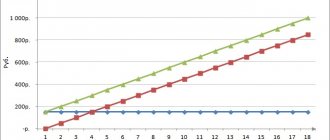“Liquidity” is the ability of some assets of a certain enterprise to quickly transform (convert) into other types of assets that are currently more in demand.
The most precise concept of “liquidity” is defined by the unit of time during which an asset is transformed, usually into cash.
Liquidity in an enterprise, in essence, shows its ability to cover its obligations. That is why they separate assets that are sold within a certain (average) period at a market price and assets for which the deadlines for execution are clearly defined.
The liquidity of an enterprise, first of all, shows its ability to cover short-term obligations for working resources. The liquidity ratio gives the most accurate and general idea of the liquidity of a company's assets. In order for an enterprise to have a normal level of liquidity, a necessary condition is that the value of assets exceed the current amount of liabilities (“golden financial rule”).
How to interpret the meanings?
“Current liquidity ratio” (or as it is also called “total debt coverage ratio”) is an analytical indicator that is based on calculating the ratio between current assets and short-term (current) liabilities.
The current ratio shows how quickly and to what extent a company can pay off its short-term debts (with a maturity of no more than one year). The source of financing liabilities is current assets that have a certain market value.
The higher the current liquidity ratio, the more stable the situation at the enterprise, since the higher its solvency. At the same time, experts mean not only the current solvency at a certain point, but also the company’s ability to pay bills in the face of a sharp change in external financial circumstances that cannot be influenced.
The occurrence of some kind of force majeure may force the company's management to sell part of its reserves. This type of activity is not the main profile of the company. The basis for calculating the current liquidity indicator is the company’s balance sheet (accounting form number 1).
Having calculated the current liquidity ratio, it is necessary to interpret it correctly.
If the coefficient value is below 1.5, then this is direct evidence that the company has some difficulties in covering its current obligations.
However, this situation can be resolved by obtaining sufficient cash flow through the company's operating activities. To do this, the expert needs to analyze the “Cash Flow Statement” (form No. 4), line 4111. For example, for companies engaged in retail trade, this situation is quite acceptable.
An overly inflated liquidity indicator often indicates insufficient use of working resources and limited access to short-term loans (including bank loans). For example, the accumulation of illiquid goods in a completely profitable company is characterized by a rapid increase in the current ratio.
Among other factors that may lead to an increase in the liquidity ratio, the following are highlighted:
- Tightening the terms of mutual settlements between suppliers and other counterparties.
- Excessive lending to customers (when a company has a large amount of receivables, and there are practically no requirements for customers regarding payment terms).
- Increase in stocks of raw materials and other materials in warehouses or in production.
At any enterprise, it is important to monitor the effectiveness of investments and evaluate the final result of the activity. For this purpose, special calculations are carried out. Profitability of core activities: calculation formula and types of profitability (current assets, fixed assets, etc.).
Read about how to calculate the break-even point here. Practice of application of the obtained indicators.
Profit from sales is the final result of the company's activities. Here https://businessmonster.ru/buhuchet/raschetyi/kak-rasschitat-pribyil-ot-prodazh-formula.html you will learn how to calculate profit and how you can increase the profitability of an enterprise.
Calculation of liquidity indicators (quick liquidity)
Quick liquidity ratio (quick liquidity ratio, intermediate liquidity ratio, QR - quick ratio) is a financial indicator that reflects the ability of an enterprise to repay all existing current obligations in a situation where, for some reason, it was not possible to sell manufactured products.
This indicator is calculated as the quotient of highly liquid current assets and current liabilities (liabilities with a short deadline):
Important! Unlike the case with the calculation of the current liquidity ratio, when calculating the quick liquidity indicator in the composition of assets, inventories (inventories) are not taken into account, since if they are sold due to the great need for cash, in comparison with other working capital they will be maximum losses for the company.
If the value of the quick liquidity ratio turns out to be equal to one or greater than 1, this is a good sign.
Current ratio: balance sheet formula
The balance sheet of an enterprise serves as the basis for calculating the liquidity ratio. Absolutely all data is contained in the balance sheet.
To calculate the indicator, you must use the following formula for the liquidity ratio: Klt=line 1200/(line 1510+line 1520+line 1550):
- Where KLT is the liquidity ratio (current).
- Line 1200 – total of the company’s working capital – raw materials, supplies, cash (sum of lines 1210, 1220, 1230, 1240, 1250 and 1260).
- Stock 1510 – borrowed resources; line 1520 – accounts payable.
- Line 1550 – other types of financial liabilities of the company.
- Lines 1510, 1520, 1550 are part of the fifth section of the balance sheet called “Current liabilities”. This section also contains the line “Deferred income”, but its value is not taken into account in the calculation of liquidity.
To analyze an enterprise on the balance sheet until 2011 (old version), the following formula is used: Klt = line 290/(line 610+line 620+line 630+line 660) ,
- where Klt – liquidity ratio (current);
- line 290 – total of the company’s working capital;
- Stocks 610, 620, 630 and 660 are the company’s short-term financial liabilities.
The formula for calculating the coefficient of the current level of liquidity can be written based on the degree of liquidity of the components of working resources, as well as the urgency of repaying debts: Klt = Ak1+Ak2+Ak3/(Pa1+Pa2) ,
- where Klt – liquidity ratio (current);
- Ak1 – lines 1240 and 1250 – assets with a high level of liquidity;
- Ak2 – medium liquid assets, line 1260;
- Ak3 – assets with a low level of liquidity, lines 1210, 1220, 1230;
- Pa1 – priority (urgent) obligations;
- Pa2 – short-term loans (current liabilities), lines 1510 and 1550.
The higher the liquidity of working capital, the faster they can turn into cash.
How to calculate the liquidity indicators of an enterprise using general formulas and the balance sheet
For each liquidity indicator, the following statement is true: the liquidity ratio is calculated as the ratio of the cost of a certain type of property (according to the classification according to the period of sale) to the amount of short-term liabilities. Information for carrying out calculations can be found in the company’s balance sheet (usually for this purpose an aggregated form is compiled - enlarged, generalized).
Important! Information on current liabilities can be determined as a result of Section V, but only if provisions and deferred income are not material, they are not actually debt.
If the values of estimated liabilities and the amount of future income on the balance sheet take on significant values, in the formulas for calculating indicators, the amount of debts to creditors and obligations on borrowed funds, taken according to the lines of Section V, should be used:
| General formula | Balance formula |
Normative value
Standard values of current liquidity ratios are determined based on methodological guidelines for conducting a financial analysis of a company.
The normal value of the liquidity ratio, which is accepted by most enterprises, lies in the range of 1.5-2.5.
A coefficient value less than one indicates problems with the timely payment of short-term debt of the enterprise (for the vast majority of companies). If we take a company operating in the field of retail sales or public catering, then a coefficient value of 1 will be considered normal, since these types of activities are characterized by a high level of short-term lending.
For industrial companies, the production cycle of which takes about a week, the normal value of the coefficient is considered to be 3, since these companies have a sufficient amount of inventory and work in progress.
Standard values of liquidity indicators: economic interpretation
Let's consider what the standard values of each of the liquidity ratios of organizations are, and how to correctly interpret them:
| Liquidity ratio | Normative value | Economic interpretation |
| Total liquidity ratio | Greater than or equal to 1, but not much greater than 1. | A value equal to 1 or slightly greater than 1 indicates that short-term debts can be repaid after the sale of current assets. If the value is significantly higher than 1, the company's owners are using available working capital ineffectively. |
| Absolute liquidity ratio | From 0.2 to 0.5. | If the value of the indicator is within the specified limits, it means that the owner can repay 20-50% of short-term debts in a short time. |
| Quick liquidity ratio | From 0.7 to 1. | The company has the ability to quickly pay off 70-100% of short-term debts. |
Absolute liquidity ratio
Along with the current liquidity ratio, analysts use another indicator in their activities - the absolute liquidity ratio. What is it?
The absolute liquidity ratio is a financial instrument that is equal to the ratio of cash and short-term financial investments that the company makes to short-term liabilities (the current level of liabilities).
The data for calculating the absolute liquidity indicator is the organization’s balance sheet (according to accounting form No. 1).
Today, there are a large number of application programs that allow you to quickly and easily calculate any ratio and draw conclusions about the company’s activities.
The absolute liquidity ratio shows what percentage of short-term debts can be covered by the enterprise's cash resources and their equivalents in the form of deposits, securities or other highly liquid assets.
Calculations of the liquidity ratio are of interest not only to the company’s management, but also to other (external) entities:
- investors who monitor the current liquidity ratio before investing;
- suppliers of raw materials and components who decide to grant a deferred payment;
- bankers who are looking for guarantees for the return of short-term loan funds issued to a company.
The absolute liquidity ratio is calculated using the following formula: Klt=(cash resources + short-term financial investments)/current level of liabilities.
In foreign financial analysis of enterprises, a regulatory restriction on the absolute liquidity indicator is applied. Thus, the regulatory limit Klt is 0.2. This means that every day the company must be able to pay at least 20% of the amount of short-term financial obligations.
There is no exact justification for this standard value, however, most Russian calculations of the absolute liquidity indicator. Thus, evidence of the normal activity of the enterprise is the fact that the amount of own funds should cover 20% of current (short-term) liabilities. However, for some domestic companies, given the heterogeneity of the structure of short-term debt, the KLT indicator should be at least 0.5.
Labor intensity helps to determine the ratio of effort and time as accurately as possible. Labor intensity – calculation formula and specific index standards, read carefully.
Perhaps this information will be useful to you: calculation of the average number of employees and fines for failure to provide a document to the tax service.
Absolute liquidity ratio (Cash ratio)
Absolute liquidity ratio
is a financial indicator used in analyzing a company's liquidity by calculating the ratio between all cash assets, cash equivalent assets and all current liabilities.
Synonyms: Cash Ratio, Liquidity Ratio, Cash Liquidity Ratio, Cash Ratio. The absolute liquidity ratio characterizes the company's ability to repay current liabilities (and in what proportion) using liquid working capital and other free assets. The available amount of cash is taken into account, as well as its equivalents: marketable securities, deposits and other absolutely liquid assets. Cash is understood as the total amount of cash held in the organization's cash desk, formed from the initial cash and the difference between income and expenses. Since cash reserves do not generate income, entrepreneurs strive to reduce them to a minimum sufficient for settlements with clients, counterparties and other current costs. Therefore, in banking there are regulatory requirements for the level of cash maintenance. Among commercial enterprises, there is a tendency towards a decrease in the absolute liquidity ratio, that is, a decrease in the need for cash. Since the Cash Ratio model measures only the most liquid of all assets relative to current liabilities, it is therefore considered the most conservative of all liquidity ratios used. Characteristics of the cash ratio:
1) Taken into account in the indicators of urgent and current liquidity. 2) Used in the company's credit profile. 3) Excludes inventory and accounts receivable from the calculation. That is, the ratio demonstrates the extent to which a company can pay its current obligations without relying on the sale of inventory or relying on the collection of accounts receivable. 4) Characterizes the ability to immediately pay off the current short-term obligations of the enterprise - that is, whether there are resources capable of satisfying the claims of creditors in a critical situation. Therefore, this indicator is taken into account by future suppliers with relatively short credit terms. For strategic investors, the absolute liquidity of an enterprise is less significant.
Calculation of absolute liquidity ratio
Cash Ratio Formula: CR = Cash + Short-term market investments / Current liabilities
Data for calculation can be obtained from the balance sheet. It should be taken into account that the formula ignores the time of receipt and payment of funds.
Standard value of Cash Ratio
The recommended value of the absolute liquidity ratio is >0.2. For different industries, standard values may deviate from the recommended values.
| Indicator value | A comment |
| less than 0.2 | The value of the indicator below the standard demonstrates the loss of solvency, the inability of the company to pay off its current obligations at the expense of liquid current assets. |
| from 0.2 to 0.5 | Recommended indicator interval. |
| over 0.5 | An indicator value in excess of the recommended one indicates ineffective and irrational use of funds that could be used for the development of the enterprise. This also indicates the presence of unclaimed amounts of money in accounts. |
Option 1. When the value of all coefficients decreases
The most obvious interpretation of this situation is the presence of negative trends in the company's solvency.
The coefficients can acquire such values in the case when, with an increase in the volume of short-term loans attracted by the company, there is no increase in its current assets. This situation may arise when a company contributes cash to part of its non-current assets at the expense of short-term liabilities. This is not good because it increases the risk that the company may not repay its current debts. But, on the other hand, many organizations operate with such a balance of lending activities, some of which do not attract long-term loans at all. In this case, to clarify the situation, you need to pay attention to the company’s cash turnover. The company can receive large income, which will not “linger” on the balance sheet, while making a profit in the form of dividends, which are paid throughout the year. Thus, debts will be paid on time, while the picture itself regarding solvency according to balance sheet data may not look very good.
Also, such indicators can arise when a stable or slight decrease in the volume of short-term liabilities occurs with a noticeable reduction in the volume of current assets. In such a situation, the company can also finance non-current assets with short-term loans. But this may indicate losses in the company’s core activities. When selling goods at a price below cost, the volume of current assets decreases and accounts payable do not decrease. Losses, in this case, can be paid from retained earnings for previous years.
Finally, another option in which the value of all liquidity ratios may decrease over several periods may be that before their decrease the values were irrationally high. The value of the current liquidity ratio may decrease due to the optimization of inventory. The quick liquidity ratio may decrease due to improved work with debtors. Well, the reason for the decrease in the value of the absolute liquidity indicator may be the reduction in losses of additional income on the accounts of large and unjustified amounts of free cash.
Types of liquidity
When analyzing the solvency of an enterprise, specialists take into account both assets and liabilities. In general, the distribution of the main financial parameters according to the degree of feasibility is as follows:
| Organizational assets | Liabilities of the organization | ||||
| Level | Liquidity level | What is included? | Level | Repayment term | What is included? |
| A1 | Highest feasibility. Assets can be sold as quickly as possible. | Cash, bank accounts, short-term financial investments. | P1 | Repayment is required as soon as possible. | Debt to credit institutions. |
| A2 | High feasibility. Time for complete sale of assets is up to 1 year. | Accounts receivable for a period of up to 1 year. | P2 | The repayment period is at an average level. | Short-term financial liabilities and consumer loans. |
| A3 | Low feasibility. The sale of assets can be carried out over a period of one or more years. | Accounts receivable for a period of more than 1 year, value added tax refund, finished production, inventories of goods. | P3 | Low maturity. | Long-term financial obligations. |
| A4 | Unliquid. Independent sale of assets is impossible. | Non-current assets, furniture. | P4 | Permanent liabilities. | The organization's own capital. |
It makes sense to look at each type of asset and liability in more detail. So, assets are divided into:
- Highly liquid with the A1 index. Such assets include financial assets held in bank accounts, in the form of cash, in short-term bank deposits, in shares and other highly liquid securities quoted on the stock market. From an accounting point of view, highly liquid assets can be calculated as follows: A1 = line 252 + line 253 + line 260.
- Medium liquid assets with index A2. Second-level assets are represented by accounts receivable to the enterprise, for example, if the products have already been shipped, but the money for them has not yet been received. In accounting, assets with index A2 can be calculated as follows: A2 = line 240 + line 215 + line 251 + line 270 + line 220.
- Low-liquid assets with the A3 index. This type usually includes materials, raw materials, long-term deposits, and VAT on purchased goods. A3 assets are calculated using the formula: A3 = line 210 – line 215 – line 216 + line 140 – line 143.
- Hard-to-sell assets with index A4. Class A4 contains long-term accounts receivable, work in progress, industrial equipment, cars, land, and funds invested in subsidiaries. The formula for accounting calculation of A4 assets is as follows: A4 = line 190 – line 140 + line 143.
Currently reading: What is accumulated coupon income on bonds, or ACI?
An organization’s liabilities used in the study of balance sheet liquidity are usually divided into four types according to maturity:
- Urgent repayment with index P1. Such liabilities include debts to shareholders, debts to banks, loans not repaid on time and other short-term obligations. You can calculate the amount of these liabilities using the formula: P1 = line 620 + line 660.
- Repayments of moderate maturity with index P2. This includes loans taken from microfinance organizations and loans with a repayment period of less than a year. In accounting, liabilities P2 are considered as follows: P2 = line 610.
- Non-urgent repayment with index P3. Non-term repayment liabilities generally include loans with a repayment period of more than 12 months. Accountants consider P3 as: P3 = line 610.
- Permanent liabilities that do not require repayment with index P4. This includes the totality of funds directly owned by the enterprise. Calculation of P4 liabilities is carried out according to the following formula: P4 = line 490 + line 630 + line 640 + line 650 – line 216.
Option 2. When the values of all liquidity ratios increase from period to period
As in the previous case, this situation may indicate that the company is increasing its solvency. This may indeed be the case. But exactly the same trend may be a sign of a dangerous state of affairs regarding the financing of current assets from long-term loans received. That is, the funds received from these loans can increase the volume of current assets and therefore, when calculating indicators, solvency will be higher, but in reality the circumstances are not so rosy.
This may be evidence that the company’s “property separation” from its owners is actually artificial. This situation is typical only for small and medium-sized businesses. Raising funds from owners may be a solution to correct the previous excessive withdrawal of received income as dividends and redistribution of funds among affiliates.
Recall that we are looking at relative indicators. With their simultaneous growth, the company's business may decline. Sales of goods are becoming less and less, and the number of deliveries is also becoming less, but the decrease in purchases occurs a little faster than the decrease in sales and income received by the company. This may cause an increase in liquidity ratios, but this situation is unlikely to be favorable for the company.
And the last reason why there may be an increase in liquidity indicators may be that the company’s current assets were irrationally distributed and opportunities to expand the business by attracting additional short-term loans were missed.
Note that neither the first nor the second option relates in any way to the company’s accounting policy. Why? We considered situations in which the values of all liquidity ratios, including the absolute liquidity indicator, were unidirectional. Accounting policies cannot affect the amount of funds in the company's accounts.









